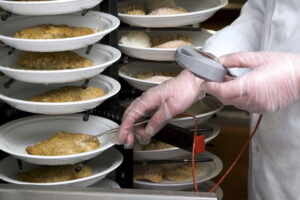With health department scores becoming increasingly important to diners, ensuring a clean and safe kitchen is crucial. Our experienced auditors, including former food safety instructors and ServeSafe committee members, conduct thorough inspections of your facility, identifying visible infractions and offering actionable suggestions for improvement. Beyond protecting against food borne illness and potential closures, maintaining high food safety standards instills pride in chefs and restaurant owners alike. EyeSpy’s Food & Safety Audits provide the expertise needed to uphold these essential standards.
SkyTab: a POS worth switching for
Toast is the norm, but let’s be honest—when it comes to the perfect POS system, we’re still searching. SkyTab might just be the answer.
What stood out:
- Integrated credit card processing = lower fees
- Local tech support from industry pros, not call center scripts
- Simple setup, sleek design, and backed by Shift4
If you’re getting patios or offsite catering ready for the warmer months, having tech that doesn’t melt down under pressure is key. SkyTab feels like the kind of partner we—and our clients—want when the heat turns up.
Henrik Beverage Systems: cold, clean, fast
Imagine pouring a perfectly chilled drink at 0°C without ice, without a fridge, and without the wait. Henrik Beverage Systems makes that possible. Their draft tech chills kegged drinks instantly and works anywhere—from a rooftop bar to a remote catering gig.
It’s a standout for:
- Restaurants
- Spring/summer patios
- Catering companies
- Festivals, weddings, and pop-ups
No foam waste. No bulky coolers. Just perfect pours, every time. Henrik is leveling up beverage service with sleek, sustainable, and fast solutions.
Craft NA cocktails: the new standard
Forget overly sweet mocktails. The focus is shifting to craft non-alcoholic cocktails—refined, thoughtful, and priced like they belong with the best.
Here’s how to make them work:
- Presentation matters: think dried citrus, herbs, great glassware
- Use NA distillers like Lyre’s to elevate flavor and feel
- Tap into your distributor for training and recipe support
- Don’t hide them—give NA cocktails a proud spot on the menu
These drinks aren’t just for non-drinkers. They’re for anyone moderating—whether it’s for pregnancy, wellness, or a reset. Craft NA is about inclusion, celebration, and creating something special.
Google tips from KLI Brands
Maria Duron from KLI Brands gave a fantastic session on getting the most from Google. From SEO to reviews to data tracking, she made it feel doable.
Top reminders:
- Claim and update your Google Business Profile
- Use search-friendly keywords—think like your guests
- Keep an eye on what’s working, and adjust as needed
She also offers a free weekly webinar for small businesses looking to improve their Google game.
Marketing meets community and competition
This trend stood out: blending smart marketing with real community impact.
What we’re bringing back:
- Work with suppliers to sponsor contests and giveaways
- Make your community support visible on your website—add clear instructions for donation requests
- Boost team connection with internal competitions
- Use social to highlight all of the above
It’s not just good PR. It’s real engagement that builds long-term loyalty.
Leadership lessons from Mike Bausch
Mike Bausch, restaurant owner and author of Unsliced, delivered a standout session on smarter leadership.
Here’s what stuck with us:
- “Task on/task off” meetings: share updates via email, use meeting time to solve
- Cap meetings at 90 minutes
- Habits take 21–28 days to form and 7 repetitions to stick
- Not all leaders learn the same—some need visuals, others need role play. Adapt and repeat
His advice was practical, grounded, and totally aligned with how we coach leaders in the field. We loved it.
Spring and summer bring new energy, new challenges, and new ways to connect with guests. From better POS systems to refined NA cocktail programs, from faster beverage service to smarter marketing—it’s all about getting sharper and staying ahead.







